Abstract
The main goal of this paper is to increase the active/reactive power extracted from variable-speed dual-rotor wind power (DRWP) based on doubly-fed induction generators (DFIG) by optimizing its operation using advanced direct vector control. First, the dynamic modeling of different parts of the system is introduced. The DFIG is modeled in the Park reference system. After that, the control techniques are introduced in detail. Direct vector command (DVC) with four-level fuzzy pulse width modulation (FPWM) is used to control the rotor current, thereby controlling the reactive power and active power of the generator. Then, use the neural network design to replace the traditional proportional-integral (PI) controller. Finally, the Matlab/Simulink software is used for simulation to prove the effectiveness of the command strategy using 1.5 MW DRWP. The results show good performance in terms of response time, stability, and precision in following the reference under variable wind speed conditions. In addition, the total harmonic distortion (THD) value of stator current is about 0.13%, being a bit less than other THD values reported in the literature.
1. Introduction
Wind turbines (WT) have become the subject of intensive research in recent years, which are focused on optimizing their operation related to reliability, maintenance, costs, and cyber-security issues [1,2,3,4]. Two different WTs are usually used: vertical axis WTs (VAWTs) and horizontal axis WTs (HAWT). HAWT has a single rotor turbine (SRWT) and three blades and has been widely used as a traditional kind of WT. On the other hand, a dual-rotor WT (DRWT) is a type of horizontal-axis WT, which consists of two rotors rotating in opposite directions on the same axis [1]. Compared to classic WTs, this type provides higher torque values. In [2], an in-depth critical study between VAWT and HAWT is presented. The research focuses on the challenges facing HAWT, especially in high-energy systems. VAWT offers solutions to some of the direct challenges HAWT faces in terms of reliability, maintenance, and costs, especially in the marine environment. In [3], a new study was introduced to reduce the number of WTs installed in a wind farm based on the Binary Correct Programming Method (BIP). In [4], an integrated fuzzy proportional command is introduced into the dynamic behavior of WT blades together with traditional proportional control to adjust the pitch angle. Today, many installed wind turbines are equipped with doubly-fed induction generators (DFIGs). The DFIG is directly connected to the grid. On the other hand, DFIG is the most important generator for variable speed WTs. Several methods are suggested to command DFIG-based wind power generation for optimizing its operation, which il be discussed in the next section. The field-oriented control (FOC) method is among the most popular methods used to control DFIG due to its simplicity and ease of implementation. This method is of two types: direct vector control (DVC) and indirect vector control (IVC). The DVC control is simpler compared to the IVC technique. But, the IVC control gives minimum power ripples and harmonic distortion of stator current of DFIG. On the other hand, the main problem with the FOC technique or DVC and IVC technique is that it does not give satisfactory results in the event of a change in the machine’s parameters, and this is a negative and undesirable thing. This is due to the use of the proportional-integral (PI) controller and hysteresis comparators. Several research works have been published in this field to improve the performance of the generator, and among the most famous methods that provided better results, we find direct control of torque and direct control of power as the best methods. However, despite the obtained results, the problem of power and current fluctuations remains.
The research topic presented in the present work is the optimal control of a high-power generator integrated into dual-rotor wind power (DRWP). Note that this generator has already been studied in previous works by many authors [5,6].
In this work, a new method is proposed to reduce these ripples as well as significantly improve the performance and efficiency of the DFIG. The method proposed in this paper is mainly based on the modified DVC method as will be presented in this paper. So, in this work, a new method for DVC based on neural networks and a new pulse width modulation (PWM) technique are proposed to optimize the operation of the DFIG-based DRWP system.
To improve the performance of the DVC method (the robustness, no ripples of the active and reactive power, and a minimum value of the total harmonic distortion (THD) of stator current), we propose to use the neural DVC method (NDVC) to integrated the DFIG driver into the DRWP system. New four-level PWM technology based on the fuzzy logic controller is proposed, being easy to use because the structure is simple. This technology reduces the ripples of torque and active power and improves robustness to parameters uncertainty of the DFIG-based DRWP system.
This work puts forward a new DVC control scheme, shows the results of the relevant simulation of the DFIG-based DRWP system, and compares the proposed robust technique with the classic DVC method. The objective of this paper is to apply the designed technique to adjust and command the stator reactive and active power of the DFIG driver provided by the four-level fuzzy PWM technology. The simulation results validate that the NDVC method with the designed four-level FPWM technique has a very robust behavior (almost like the control using a conventional neural network) and it works with low power ripples during the steady-state. So, this proposal presents an optimal DFIG drive command, which is a robust and ripple-free DC technique.
In summary, the novelty and the main contributions of the paper are listed below:
- ✓
- A new DVC control scheme is proposed and designed for the DFIG-based DRWP system.
- ✓
- The proposed DVC control scheme with fuzzy PWM technique and neural algorithms is a robust strategy compared to classical DVC control with PI controllers and improves the dynamic performances of the DFIG-based DRWP system.
- ✓
- The proposed method is simple and therefore easier to implement compared to the traditional technique. In addition, the proposed method reduces the reactive and active power ripples and minimizes the total harmonic distortion value of the stator current of DFIG compared to other reference strategies proposed in the literature.
This work is organized as follows. Section 2 presentation of some work related to this paper. The methodology of research is presented in Section 3 and its subsections. Section 3.1 explains the designed fuzzy PWM technique for a multilevel inverter. The DRWP system is presented in Section 3.2. Section 3.3 explains the traditional DVC method for the DFIG-based DRWP system. The proposed DVC method, which is based on neural algorithms and the four-level fuzzy-PWM technique, has been presented in Section 3.4. Numerical simulation results are presented in Section 4. The conclusion is given in Section 5.
2. Related Work
To identify the research gaps in the field of research addressed in this research study, the main control methods recently proposed in the literature are critically analyzed in this section.
It is worth mentioning that several methods have been proposed to control DFIG to obtain very satisfactory results in terms of current quality, THD value, as well as power ripples. In [7], a finite position set model reference adaptive observer (FPMRAO) method is designed to command doubly-fed induction generators. In [8], a Fractional Proportional Integral (FOPI) controller was proposed to control the Tidal Stream Turbine (TST) based on DFIG. In [9], to improve the characteristic of DFIG, three methods are combined. These methods are heart exchange optimization (TEO), fuzzy controller, and second-order sliding mode control (SOSMC). In [10], a new technique based on amplitude control was designed to control WTs based on doubly-fed induction machines. The performance of DFIG-based wind turbines is improved through the direct power control (DPC) of the SOSMC controller [11]. In [12], the behavior of a fully developed DFIG-wind turbine system model was studied using MATLAB software® under defective situations. More precisely, short-circuit faults in both the rotor terminals and back-to-back inverter are checked at typical wind speeds. It has been proposed to combine two methods, which are different in principle, to minimize torque ripples and reactive power fluctuations of the DFIG-based dual-rotor WT (DRWT) [13]. The first method is based on the super twisting algorithm (STA) and the second is based on the synergetic control theory. The proposed technique is more robust and it is easier to adjust the tuning parameters compared to the classical method. In [14], the terminal sliding mode controller (TSMC) reduced the harmonics and ripples of the DFIG current compared to the traditional SMC method. In [15], a new strategy was designed based on a new fractional-order command strategy to minimize active power and current ripples of DFIG. The simulated results show that the current ripples are lower than when using the fractional-order control strategy. In [16], a new strategy is designed for the DFIG control. This strategy is based on the backstepping control and Lyapunov theory. This designed strategy is a simple algorithm that gives better results than the classic method. In [17], a new DPC method was designed based on the fuzzy-genetic algorithm (FGA) to reduce torque and active power ripples of DFIG. The designed strategy improves transient response speed and overall precision as well as significantly minimizing stator current ripples under non-ideal grid conditions. In [18], a robust nonlinear method for wind turbines based on DFIG is proposed. The main idea in [18] is to use backstepping control to decouple DFIG stator reactive and active power for better performance. In [19], a new robust technology based on state feedback linearization control technology is designed to control doubly-fed induction machines. The power ripples are reduced by using the proposed technique. The simulation results show the characteristics of the proposed control technique. In [20], an improved DPC control was proposed to control DFIG. The operation of the improved DPC strategy is based on the principle of stator voltage-oriented command (VOC), in which the voltage is aligned with the quadrature axis of the rotating reference frame. In [21], a subsynchronous damping control (SDC) technique was designed to suppressed the subsynchronous resonance (SSR) of the doubly-fed generator. In [22], a coordinated stator reactive and active power control strategy based on model predictive control (MPC) was designed for DFIG-based WTs with distributed energy storage systems (ESS). The design method is simple and the stator current harmonics are among the smallest reported in the literature. In [23], a new adaptive SOSMC-DPC strategy for DFIG driven by wind turbines is proposed. Comparative numerical simulations are performed under the three DPC technologies on a 2 MW DFIG under unbalanced and balanced grid voltages. Adaptive gain SOSMC-DPC realizes reactive and active power regulation under the two-phase fixed reference frame of unbalanced and balanced grid voltage. In [24], DC voltage regulation has been proposed to control doubly-fed motors. This design technique is a simple control solution, but it does not reduce the ripples of reactive and active power. In [25], to reduce power ripples, the author proposed a robust nonlinear super-twisting fractional-order TSMC (STFOTSMC)for the rotor-side and grid-side converters of 2 MW DFIG. In [26], the author proposed a novel adaptive high-order SMC to suppressed the subsynchronous control interaction of the WT based on the series-compensated DFIG. Proposed DFIG voltage modulation DPC uses extended power theory under unbalanced grid voltage conditions. Four different methods were compared with each other to determine which technique is superior to other methods in reducing the active power ripple ofDFIG [27]. The results show that, compared with partial feedback linearization, the adaptive STA method can reduce the active power ripple. In [28], a traditional stator flux-based FOC technique based on a full-order adaptive observer is proposed to control the doubly-fed induction machines. The proposed technique is simple and easy to implement. The proposed technique improves the characteristics of generator-based wind power. A non-linear control technique for grid-connected current source converter (CSC) is proposed in [29]. The nonlinear control technology of active power and reactive power of a doubly-fed generator is realized by feedback linearization. A fuzzy-SOSMC control for doubly-fed induction machines is proposed in [30]. This proposed strategy is a robust technique that improves the response time of the active and reactive power compared to the traditional technique. On the other hand, the fuzzy-SOSMC control reduced the active and reactive power ripples. In [31], posteriori multi-objective optimization (MOO) is applied to adjust the parameters of SOSMC control technology, which commands the grid-side converter (GSC) of DFIG in such a way that it is not affected by unbalanced and harmonic distortions of the grid voltage. In [32], direct torque control (DTC) is applied to DFIG driven by WTS connected to the grid. The method is based on the regulation of torque and rotor flux, which are indirect estimates using voltage and current. Comparing these estimated variables with the reference values using the traditional hysteresis comparator will result in digital control signals. A new DPC control technique based on DFIG and grid-connected WTS is proposed [33]. The designed DPC method uses nonlinear SMC technology to directly calculate the required rotor control voltage to eliminate the instantaneous error of stator reactive and active power, without the need for non-linear control based on SMC technology. In [34], the nonlinear control based on the SMC technique has been proposed to minimize the ripple of both torque and active power of the doubly-fed motor. Fuzzy fractional order robust command has been designed to control WT conversion systems based on doubly-fed machines [35], being experimentally tested using a processor-in-the-loop (PIL). In [36], the author proposed the DPC method for DFIG by using a neural algorithm with a multilayer perceptron structure (MPS). This design technique generates quadrature and direct-axis rotor voltage signals based on the voltage and the stator current measured by the Hall sensors. The input variables of the design method are reactive power, rotor speed, and active power reference values, and their respective errors. The designed technology is easy to implement and can minimize the ripples of active power, current, and torque of the doubly-fed motor. Other methods have been proposed with the same objective in the following scientific works [37,38,39,40,41]. In [42], the FOC technique is the most commonly used method in the DFIG command. This technique uses linear controller proportional-integral (PI) to control the DFIG converter. Two different types of traditional FOC strategies are used to command and regulate the reactive and active power of doubly-fed generators. The first method is direct vector control (DVC) and the second method is indirect vector control (IVC). In [43], a DVC technique based on neural space vector modulation (NSVM) technology is proposed. However, the proposed technique gives minimum ripples in current, torque, reactive power compared to traditional DVC with the PWM technique. On the other hand, the proposed strategy improves the response dynamics of the DFIG-based wind power. In [44], a DVC strategy based on the fuzzy SVM strategy was proposed to reduce the ripples of current, flux, and torque of DFIG. An indirect vector control (IVC) is proposed to minimize the current, active power, and torque ripples of the DFIG using the two-level fuzzy space vector PWM technique [45]. The IVC strategy based on the neuro-fuzzy method with the traditional SVM technique is proposed to reduce the current and torque ripples of the induction generator [46]. This proposed method is simple, robust, and gives minimum power ripple compared to the classical IVC command. In [47], the authors presented a nonlinear controller based on the sliding mode control to maximize the extracted energy of the DFIG controlled by the IVC technique. The proposed technique is more robust compared to the traditional technique. In [48], the authors presented an IVC method based on the hysteresis rotor current controller. The experimental results showed the superiority of the designed IVC strategy. The traditional IVC control scheme for DFIG-based WT systems is a simple algorithm, which has a fast dynamic response in comparison with other well-developed technique approaches, such as the traditional DVC method. The simplicity of this strategy is given by the use of PI regulators for the reactive and active power. However, the controller is linear, and the regulator has a non-constant switching frequency.
There is a multitude of strategies proposed to improve the efficiency of the generator and the quality of the electricity generated, some of which are presented in Appendix A. The main features of these methods and the proposed method were summarized in Table A1 for correct comparison of the reported performance and the identification of research gaps.
The following section will present the modeling and design of the command-and-control blocks integrated into the proposed control technique.
3. Material and Method
To understand the research work performed in this paper, the design, testing, and validation stages of the NDVC-FPWM control method are shown in Figure 1 and presented in the next subsections.
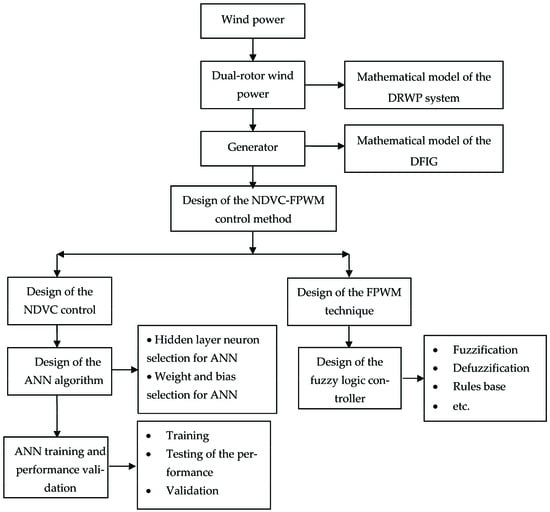
Figure 1.
Diagram of research steps followed in this paper.
Also, the details of the design stages are presented in the appendices.
3.1. Fuzzy PWM Technique
In the field of energy electronics, traditional PWM technology is the core of AC motor control and has been proven effective in driving modern semiconductor power devices. Most energy electronic circuits are controlled by various forms of traditional PWM signals. The PWM strategy is an effective command strategy, usually used as a command strategy for generating analog signals from digital devices such as microcontrollers. On the other hand, there are three traditional kinds of PWM strategies: leading-edge modulation, trailing-edge modulation, and pulse center two edge modulation/phase correction PWM.
The PWM signal is normally obtained, as in Figure 2. To get a PWM signal, we need two signals of different shapes and frequencies. The first signal is a sinusoidal signal and the second is, for example, a sawtooth signal. The latter has a frequency greater than the sinusoidal signal. In addition, we need a comparator to compare these two signs. The comparator compares the two signals and generates a PWM signal as its output waveform. If the value of the sawtooth signal is greater than the PWM signal, the PWM output signal is in the “high” state, otherwise, it is in the “low” state. Therefore, the value of the input signal amplitude determines the output of the comparator, which defines the pulse width generated at the output [49]. Traditional PWM technology has many advantages compared with other modulation strategies used in AC machines. For example, the PWM technology is simple, provides accuracy and fast response time. It provides a high input power factor, low initial cost, and is easy to implement. The PWM strategy can help the motor to produce maximum torque even at low speeds. However, the PWM technology has the following disadvantages. Due to the high PWM frequency, the switching loss is quite high. It can cause radio frequency interference. This strategy provides a high THD value for the current [49]. In [50], the author proposed to apply PWM technology and neural algorithms to wind turbines based on DFIG. In [51], a three-level PWM technology based on fuzzy logic controllers is proposed. The designed modulation strategy can achieve a fast transient response, while the THD of the output voltage is very low during steady-state operation.
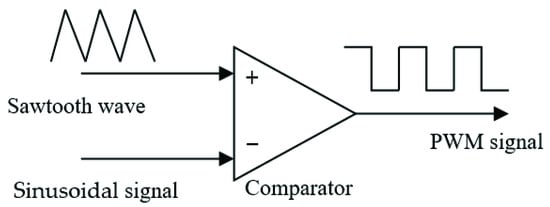
Figure 2.
Generation of PWM signal.
In this work, we use the four-level PWM method to command the converter of the DFIG-based DRWT systems. Figure 3 shows the structure of the four-level PWM method. In a four-level PWM strategy, three-phase voltages are compared with three sawtooth waves.Three comparators are used In a four-level PWM strategy to generates a PWM signal. The structure of the hysteresis comparators of the four-level PWM technique is shown in Figure 4. Comparing with the space vector modulation technique, the four-level PWM strategy is a simple algorithm, gives fewer current ripples, easy to implement, fast response time, and is less dependent on DFIG-DRWP parameters. But the four-level strategy generates a variable-frequency control signal.
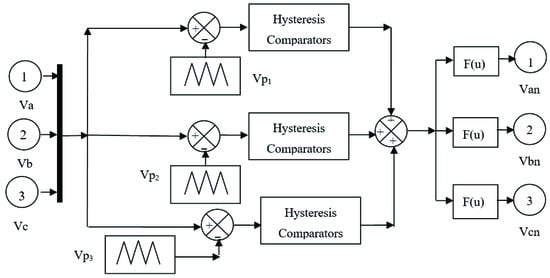
Figure 3.
Conventional four-level PWM strategy.

Figure 4.
Traditional hysteresis controllers.
To improve the effectiveness of the DFIG in the context of DRWT production, we propose a hybrid modulation technique the combines fuzzy logic and PWM strategy. Figure 5 shows the basic structure of a 4-level fuzzy PWM technique. This strategy is a modification of the conventional four-level PWM strategy, where the hysteresis comparator has been replaced by a fuzzy logic controller (FLC). This designed modulation technique is a simple scheme, robust, and reduced the THD of the current compared to SVM and conventional4-level PWM strategy. In addition, the structure of the fuzzy hysteresis controllers of the 4-level PWM technique is shown in Figure 6.
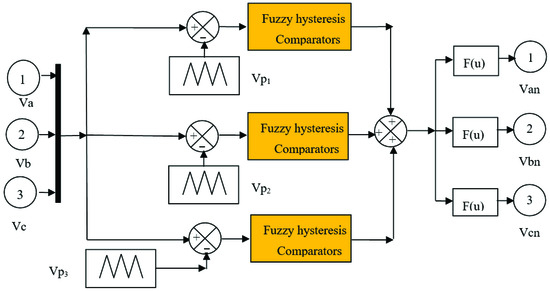
Figure 5.
Schematic diagram of the four-level fuzzy PWM strategy.
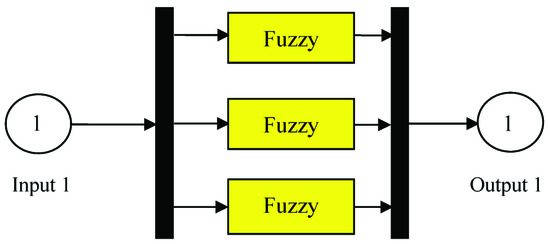
Figure 6.
Schematic diagram of the FLC hysteresis comparators.
The FLC methods are widely used for system identification, control, pattern recognition problems, and many other applications developed in academia and applied in industry. However, the fuzzy logic theory was first designed by Zadeh [52] in 1965. This technique is a method based on observation and engineering experience. This technique is widely used in AC motor drive commands [53,54,55].
The membership degree of an element to the set is defined by the following Equation (1):
where .
In this condition, μA(x) represents the MF degree of the element to set A. In this paper, we will use the following notation: A(x) = μA(x) for all The design of the fuzzy logic controller has been detailed in Appendix B.
3.2. DRWP Model
The DRWP system is a wind turbine for solving both problems that are based on a single rotor WT (SRWT). The DRWP uses two wind turbines rotating in opposite directions on the same axis. However, the SRWT system is the most common WT used the generates electrical energy. The mathematical model of the DRWP is different from the SRWT system. The DRWP system has been proposed as new wind power, as shown in Figure 7. The DRWP system gives more power coefficient and aerodynamic torque compared to the SRWT system. The DRWP system design is composed of two wind turbines, the main turbine and the auxiliary turbine [56]. The control of the DRWP system is difficult compared to the SRWT system. The total aerodynamic power of the DRWP system is the auxiliary turbine power (PA) add to the main turbine power (PM) as shown by the following equation:
where:
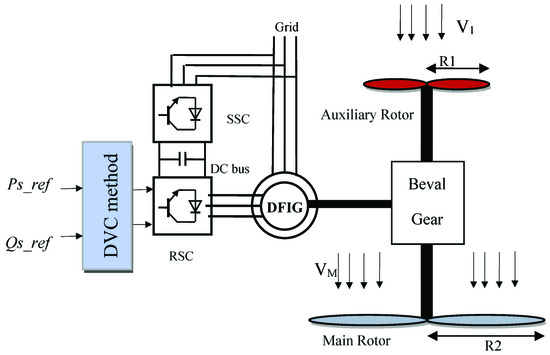
Figure 7.
Block diagram of DRWP with a DFIG.
- PM: Main turbine power.
- PA: Auxiliary turbine power.
- PT: Total aerodynamic power.
The total torque of the DRWT system is given:
where:
- TM: Main turbine torque.
- TA: Auxiliary turbine torque.
- TT: Total aerodynamic torque.
Equation (4) represents the aerodynamic torque of the auxiliary turbine [57].
Equation (5) represents the aerodynamic torque of the main turbine.
where λA and λM are the tip speed ratio of the main and auxiliary turbines, ρ is the air density, RM and RA are the blade radius of the auxiliary and main turbines, and wM and wA are the mechanical speed of the main and auxiliary turbines.
The tip speed can be given by Equations (6) and (7) for the auxiliary and main turbines, respectively.
where VM is the speed of the unified wind on the main turbine and V1 is the wind speed on an auxiliary turbine.
Wind speed is used at the level of the main and auxiliary turbines to calculate the tip speed ratio.
Equation (8) is used to calculate the wind speed at any point between the main and auxiliary turbines.
where Vx is the velocity of the disturbed wind between rotors at point x (x is the non-dimensional distance from the auxiliary rotor disk), and CT is the thrust coefficient (CT = 0.9). In our work, we take a value of x as 15 m, which denotes the distance between the rotors [57].
The power coefficient is given by the following equations:
where β is pitch angle.
The DFIG is the most popular variable-speed generator for wind power applications due to its lower cost, control flexibility, and superior performance. The mathematical form of the generator is illustrated by the following equations:
Equation (12) represents the mechanical equation of the generator.
Equation (13) represents the torque equation of the generator.
where f is the viscous friction coefficient, p is the number of pole pairs, Tr is the load torque, Ω is the mechanical rotor speed, and J is the moment of inertia.
The active and reactive power can be calculated from Equation (14):
3.3. DVC Method
DVC or direct vector control using traditional PI is the most used strategy for DFIG-based wind turbines. In this method, two PI regulators are used to controlling the reactive and active powers [42]. However, this method is easy to implement and simple algorithm compared to indirect vector control. This strategy is detailed in [43,44]. Simplicity is one of the most important features of this method.
The principle of operation is to orient the stator flux along the axis of the rotating frame.
Equation (16) represents the stator voltage equation of the generator.
A stator current can be written by Equation (17).
A stator reactive/active power can be written by Equation (18) [41].
A torque can be written by Equation (19).
The expressions for both Vqr and Vdr are given by Equation (20) [41,42,43,44]:
Hence, Vqr and Vdr can be written as:
A rotor current can be written by Equation (22).
Starting from Equations (15) to (22), we can give a figure by which we explain the principle of operation of the DVC method. Figure 8 shows the structure of the traditional DVC technique. The objective of this method is to obtain the reference rotor voltages (Vrd* and Vrq*) from the active and reactive power errors by using two PI controllers.
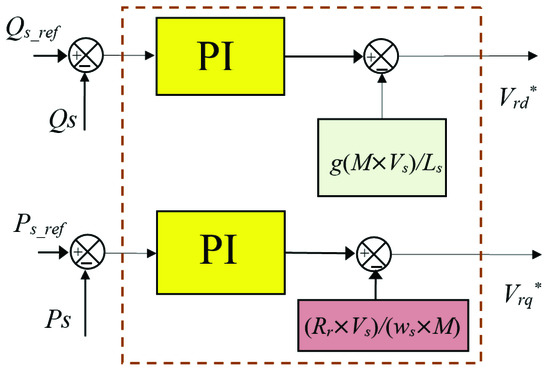
Figure 8.
Structure of the traditional DVC method.
Traditionally, DVC control is a simple technique used to control the active power of the DFIG-based wind power. This strategy is easy to implement compared to IVC control. The traditional DVC with PI controllers, which are designed to command the reactive and active powers of the DFIG-based DRWP, is shown in Figure 9. As is known, the purpose of the DVC-PI control is to obtain a direct and quadrature rotor voltages (Vrd* and Vrq*) in order to control the inverter. The Park transform is used to obtain the three-phase voltage (Va, Vb, Vc) from Vrd* and Vrq*. Despite its simplicity and ease of implementation, this method gives greater fluctuations to current, active power, and torque. On the one hand, the dynamic response is long compared to the IVC method and other techniques.
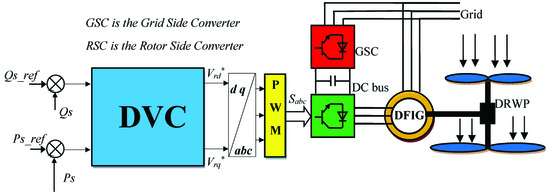
Figure 9.
DVC method of three-phase DFIG-based DRWP system.
To improve the performance of the traditional DVC control of the DFIG using the PWM technique, neural networks can be used in the place of the PI regulator, as well as the use of the FPWM technique in the place of the traditional PWM strategy. In this way, we get a more solid strategy and advantages that lead to the better. This proposed method will be explained in Section 3.4 of this paper.
3.4. Neural DVC Method with FPWM Technique
The neural DVC method (NDVC) with the five-level FPWM technique has been designed as a novel design for the improvement of current output, reactive and active power ripples, as shown in Figure 10. The objective of this proposed method is to obtain high quality Vrd* and Vrq* from active and reactive power errors. In this method, the direct and quadrature rotor voltages (Vrd* and Vrq*) are regulated by the neural networks (see Figure 11). From the observation of Figure 11, we find that the values of both Vrd* and Vrq* are related to neural networks, in contrast to the classical method, with the aim of obtaining Vrd* and Vrq* of high quality, thus reducing generator maintenance and extending the life of the inverter.
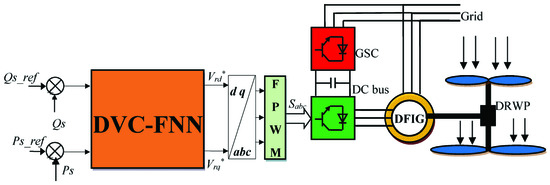
Figure 10.
DVC-FNN method of the DFIG-DRWP.
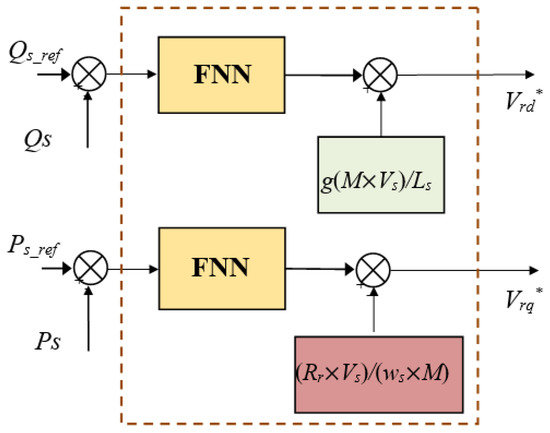
Figure 11.
Structure of the DVC-FNN method.
This method was proposed to improve the quality of the current and power generated by the generator-based DRWP system. The proposed DVC technique is simple to control and easy to implement. Durability is one of the main things we get through this proposed DVC method and that’s because of the use of neural networks and fuzzy logic controller. Also, by this proposed DVC method or intelligent DVC, the dynamic response of the generator is greatly improved. This proposed method is a change in the form of the classic method, where neural networks were used instead of the conventional PI controller and FPWM was used instead of PWM.
So, two neural controllers are being applied: a neural controller for the reactive power and another neural controller for the active power. The error for reactive and active powers controllers can be specified as follows:
Compared with the classical DVC method, the NDVC method ensures diverse advantages such as the reduction of active power ripples, torque ripples, reactive power ripples, constant switching frequency operation, and a robust command scheme. Moreover, it keeps a simple command algorithm, with minor changes to the basic algorithm of the DVC method.
In this work, feedforward neural networks (FNNs) are used [58,59].
The schematic diagram of the FNN controller based on the Levenberg–Marquardt algorithm is shown in Figure 12. This controller is more robust compared to other algorithms.
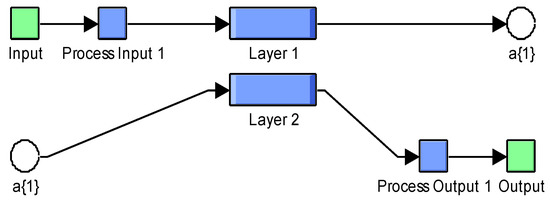
Figure 12.
FNN controller.
On the other hand, the schematic diagram of layer 1, layer 2, and a hidden layer is shown in Figure 13, Figure 14 and Figure 15, respectively.

Figure 13.
Layer 1.

Figure 14.
Layer 2.
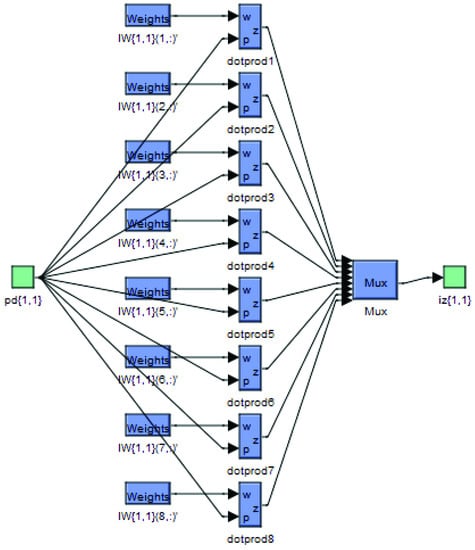
Figure 15.
Schematic diagram of the hidden Layer.
The design of the FNN controller has been detailed in Appendix C.
4. Results
The simulation results of the NDVC control with the four-level FPWM technique (NDVC-FPWM) of the DFIG-based DRWT system are compared with the classical DVC technique.
The parameters of the generator are as follows: 380/696 V, Rs = 0.012 Ω, Psn = 1.5 MW, Lr = 0.0136 H, Lm = 0.0135 H, p=2, 50 Hz, J = 1000 kg∙m2, Rr = 0.021 Ω, Ls = 0.0137 H, and fr = 0.0024 N∙m/s.
The simulation signals of the measured and reference active power (Ps) of the DFIG-based DRWT system are shown in Figure 16, Figure 17, Figure 18, Figure 19, Figure 20, Figure 21, Figure 22 and Figure 23 to compare the effectiveness of the NDVC-FPWM command scheme with the effectiveness of the classical DVC command. The Ps tracks almost perfectly their reference value Ps-ref (see Figure 16). In addition, the amplitudes of the ripples of the stator Ps are smaller and occur in a shorter period in comparison with the ripples obtained for the NDVC-FPWM command scheme (see Figure 21).
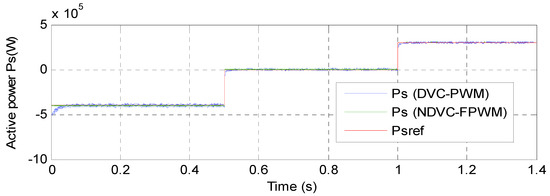
Figure 16.
Active power.

Figure 17.
Reactive power.
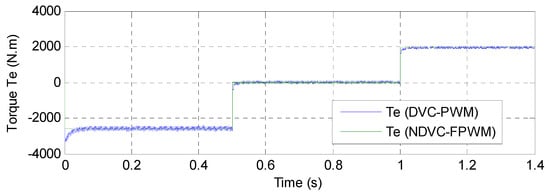
Figure 18.
Torque.
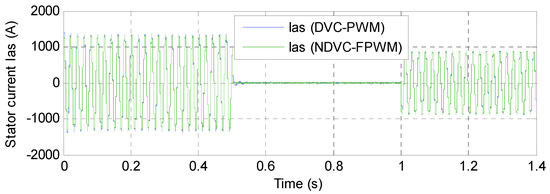
Figure 19.
Stator current.
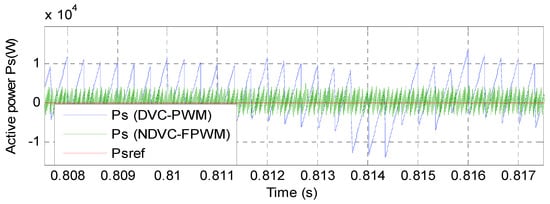
Figure 20.
Zoom in the Ps.
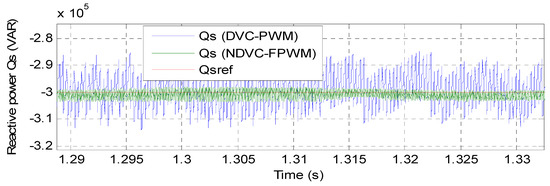
Figure 21.
Zoom in the Qs.
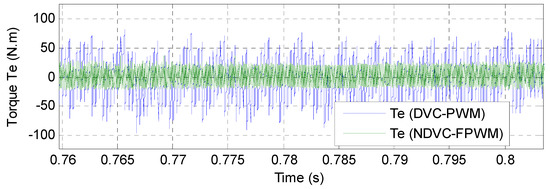
Figure 22.
Zoom in the torque.

Figure 23.
Zoom in the Ias.
For the classical DVC and NDVC-FPWM command schemes, the reactive power (Qs) tracks almost perfectly their reference value (see Figure 17). Moreover, the NDVC-FPWM command technique minimized the Qs ripple compared to the traditional DVC command (see Figure 17).
The waveforms of the torque of both control schemes are shown in Figure 18. It can be said by comparing this figure with Figure 16 that the value of the torque is related to the value of the active power. In addition, the proposed command scheme reduced the torque compared to the classical DVC command (see Figure 22).
The current obtained from the proposed methods in this work is shown in Figure 19. It can be said by observing Figure 23 and comparing it with Figure 21 that the resulting electric current is related to both the system and the reference value of the active power. This can be confirmed by the same form of current and effective power, where the greater the effective power, the greater the current, and vice versa. In addition, the classical DVC command gives more ripple in current compared to the NDVC-FPWM command scheme (See Figure 23). However, the NDVC-FPWM command scheme reduced more the response time of the torque, reactive power, current and active power compared to the classical DVC command (See Table 1).

Table 1.
Comparative analysis of response time.
On the other hand, Figure 24 and Figure 25 show the THD value of the classical DVC with the PWM technique and NDVC-FPWM command scheme respectively. From mentioned Figures, it can be said that the THD value is minimized for the NDVC-FPWM strategy (0.13%) when compared to the traditional DVC command (1.65%). The proposed method reduced the THD value by about 92.12%.
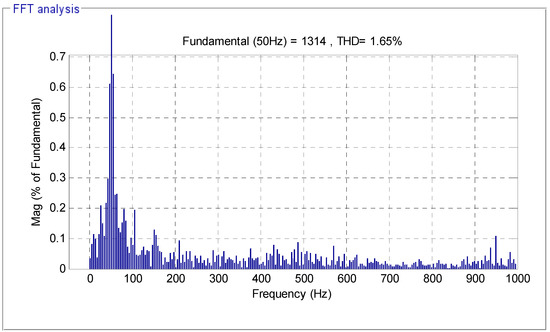
Figure 24.
THD (DVC).
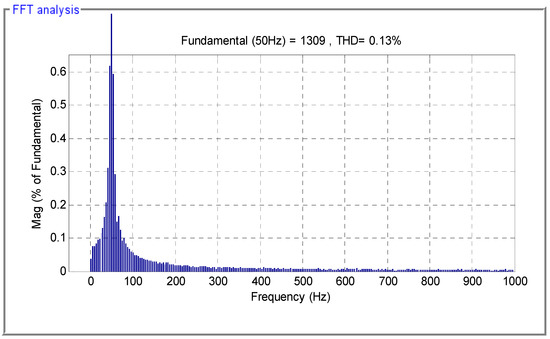
Figure 25.
THD (NDVC-FPWM).
The proposed method can be compared with the classical method from several aspects, for example, the dynamic response, simplicity, the value of reactive power ripples, etc. Table 2 shows a comparative study between the proposed methods, according to the results obtained from the numerical simulation. The proposed NDVC-FPWM technique is more robust than the traditional DVC using PI controllers except for the dynamic response, rise time, overshoot, settling time which is faster in the proposed technique than the traditional technique. On the other hand, the proposed method provided better results in terms of reactive power fluctuations, reactive and active power tracking, the quality of the produced current. But the proposed technique is complicated in calculations compared to DVC control.

Table 2.
Comparative results were obtained from the NDVC-FPWM with the DVC control.
The response time obtained in this work can be compared with two different control techniques studied in [60]. We find that the NDVC-FPWM control provided a very small time compared to DPC and neuro-second-order sliding mode control. The values are shown in Table 3. The proposed method reduced the response time to active power by approximately 64.4% and 90.11% compared with NSOSMC and DPC, respectively. As for the reactive potential, the ratio was about 5.55% and 50%, compared with NSOSMC and DPC, respectively.

Table 3.
Comparison between the proposed method and some methods in terms of response time.
In the end, we study a comparison between the designed strategy and several published works in terms of the percentage of the THD of electric current. The results are recorded in Table 4. Through this table, we note that the proposed method gave much lower percentages of the THD than some of the published methods. So, it can be said that the designed strategy in this work gives a sinusoidal current that has good characteristics in terms of ripples and THD value compared to the rest of the controls, and this is what makes the life of the devices longer and reduces the cost of maintenance.

Table 4.
Summary table of results obtained compared to other methods.
5. Conclusions
This work presents the simulation results of the high-performance DVC method for a DFIG-based DRWT system. In this paper, the converter of the DFIG is controlled by the five-level FPWM technique. The proposed control methods have been validated by Matlab simulation and the results obtained show a good tracking of the predefined references regardless of the reference powers changing.
The current injected into the grid has a low THD value, being equal to 0.13%. The proposed method presents lower active power, stator current, reactive power, and torque ripples of the DFIG-based DRWT system.
To summarize, the main findings of this research are as follows:
- A new four-level FPWM technique was presented and confirmed with numerical simulation.
- A new DVC control scheme based on neural network and four-level FPWM technique was presented and confirmed with numerical simulation.
- Minimizes the reactive power, stator current, electromagnetic torque, and active power ripples.
- A robust control scheme was proposed.
- Reduce the harmonic distortion of stator current.
In a future paper, to improve the quality of the reactive and active powers, the DFIG will be controlled using another combination of intelligent algorithms, such as genetic algorithm and PSO algorithm used for DFIG in [72].
Author Contributions
Conceptualization, H.B.; methodology, H.B.; software, H.B.; validation, N.B.; investigation, H.B.; resources, H.B. and N.B.; data curation, N.B.; writing—original draft preparation, H.B.; supervision, N.B.; Funding acquisition: N.B.; Visualization: N.B.; writing—review and editing: N.B.; project administration, N.B.; Formal analysis: N.B. and H.B. All authors have read and agreed to the published version of the manuscript.
Funding
There is no funding available for this.
Institutional Review Board Statement
Not applicable.
Informed Consent Statement
Not applicable.
Data Availability Statement
Not applicable.
Conflicts of Interest
The authors declare no conflict of interest.
Abbreviations
| List of Symbols: | |
| ϕr, ϕr* | Actual and reference rotor flux |
| Te, Te* | Actual and reference torques |
| ωn, ωr | Nominal and rotor speeds |
| θr | Rotor flux angle |
| p | Generator pole pairs |
| λ | Tip speed ration |
| Vm | Wind speed |
| Pn | Nominal Power |
| Vs, Is | Vectors of the stator voltage and current |
| Vra,b,c, Ira,b,c | Rotor voltage and current in abc frame |
| Vα,β, Iα,β | Voltage and current in αβ frame |
| Rs, Rr | Stator and rotor resistances |
| ϕαs, ϕβs | Stator flux components in αβ frame |
| Ω | Ohm (unit) |
| Ki, Kp | Integral and proportional gains |
| Lr, Ls, Lm | Rotor, stator, and mutual inductances |
| wb | Weber (unit) |
| Hz | Hertz (unit) |
| MW | Migawatt (Unit) |
| mH | Millihenry (unit) |
| N.m | Newton-meter (Unit) |
| List of Acronyms: | |
| DVC | Direct vector control |
| PI | Proportional integral |
| FLC | fuzzy logic controller |
| FNN | Feedforward neural networks |
| DPC | Direct power control |
| SMC | Sliding mode control |
| IVC | Indirect vector control |
| VAWT | Vertical axis wind turbine |
| HAWT | Horizontal axis wind turbine |
| THD | Total harmonic distortion |
| PWM | Pulse width modulation |
| FOC | Field-oriented control |
| DRWT | Dual-rotor wind turbine |
| FSMC | Fuzzy sliding mode control |
| TSMC | Terminal sliding mode controller |
| SVM | Space vector modulation |
| IP | Integral-proportional |
| DFIG | doubly-fed induction generator |
| FPWM | Fuzzy Pulse width modulation |
| DRWP | Dual-rotor wind power |
| NDVC | Neural direct vector control |
| MRSMC | Multi-resonant-based sliding mode controller |
| ISMC | Integral sliding mode controller. |
Appendix A

Table A1.
A comparative study of different techniques based on DFIG-Wind turbine.
Table A1.
A comparative study of different techniques based on DFIG-Wind turbine.
| References | Study Nature | Control | Controller | Type of Generator | Complexity | Current Oscillations | Reference Tracking | Dynamic Responses |
|---|---|---|---|---|---|---|---|---|
| Ref. [7] | Simulation | FOC | PI | DFIG | Low | High | ++ | + |
| Ref. [8] | Simulation | FOC | FOPI | DFIG | High | Low | +++ | ++ |
| Ref. [9] | Simulation | Nonlinear control | Fuzzy SOSMC | DFIG | High | Neglected | +++ | +++ |
| Ref. [10] | Simulation | Amplitude control | PI | DFIG | Low | Low | ++ | ++ |
| Ref. [11] | Simulation | DPC | SOSMC | DFIG | High | Neglected | +++ | ++++ |
| Ref. [12] | Simulation | FOC | PI | DFIG | Low | High | ++ | + |
| Ref. [13] | Simulation | DPC | Synergetic STA | DFIG | Medium | Low | +++ | ++++ |
| Ref. [14] | Simulation | Nonlinear control | TSMC | DFIG | High | Neglected | +++ | +++ |
| Ref. [15] | Simulation | Fractional-order command | FOPI | DFIG | Medium | Low | +++ | ++ |
| Ref. [16] | Simulation | Nonlinear control | Backstepping control | DFIG | High | Neglected | +++ | +++ |
| Ref. [17] | Simulation | DPC | FGA | DFIG | Medium | Low | ++ | +++ |
| Ref. [18] | Simulation | DPC | Backstepping control | DFIG | High | Neglected | +++ | ++++ |
| Ref. [19] | Simulation | Nonlinear control | Feedback linearization control | DFIG | High | Neglected | +++ | ++ |
| Ref. [20] | Simulation | DPC | VOC | DFIG | Medium | Low | ++ | +++ |
| Ref. [21] | Simulation | SDC | SDC | DFIG | Medium | Low | ++ | +++ |
| Ref. [22] | Simulation | DPC | MPC | DFIG | Medium | Low | +++ | +++ |
| Ref. [23] | Simulation | DPC | SOSMC | DFIG | High | Low | ++++ | ++++ |
| Ref. [24] | Simulation | DPC | DC voltage regulation | DFIG | Medium | Low | +++ | ++ |
| Ref. [25] | Simulation | FOC | STFOTSMC | DFIG | High | Low | +++ | +++ |
| Ref. [26] | Simulation | DPC | Adaptive High SMC | DFIG | High | Low | +++ | ++++ |
| Ref. [27] | Simulation | DPC | Extended power theory | DFIG | Medium | High | +++ | ++ |
| Ref. [28] | Simulation | FOC | Full-order adaptive observer | DFIG | High | Low | ++ | ++ |
| Ref. [29] | Experimental | Nonlinear control | Feedback linearization | DFIG | High | Low | +++ | +++ |
| Ref. [30] | Simulation | Nonlinear control | Fuzzy SOSMC | DFIM | High | Neglected | ++++ | ++++ |
| Ref. [31] | Simulation | SOSMC | MOO | DFIG | Medium | Low | ++ | +++ |
| Ref. [32] | Simulation | DTC | Hysteresis comparator | DFIG | Medium | High | ++ | ++ |
| Ref. [33] | Simulation | DPC | SMC | DFIG | Medium | Neglected | ++++ | +++ |
| Ref. [34] | Simulation | Nonlinear control | SMC | DFIG | High | Neglected | ++ | +++ |
| Ref. [35] | Experimental | Nonlinear control | Fuzzy fractional order robust command | DFIG | High | Neglected | +++ | ++++ |
| Ref. [36] | Simulation | DPC | MPS | DFIG | Medium | Low | ++ | +++ |
| Ref. [37] | Simulation | DPC | Neural controller | DFIG | Medium | Low | ++++ | +++ |
| Ref. [38] | Simulation | FOC | PI | DFIG | Low | High | ++ | + |
| Ref. [39] | Simulation | DTC | Resonant current control | DFIG | Medium | High | +++ | ++ |
| Ref. [40] | Simulation | DTC | PI | DFIG | Low | Low | +++ | ++ |
| Ref. [41] | Simulation | FOC | PI | DFIG | Low | High | ++ | + |
| Ref. [42] | Simulation | FOC | Neuro-fuzzy | DFIG | Medium | Low | ++ | ++ |
| Ref. [43] | Simulation | DVC | Fuzzy SMC | DFIG | Medium | Neglected | ++++ | +++ |
| Ref. [44] | Simulation | FOC | Neural SOSMC | DFIG | High | Low | ++ | +++ |
| Ref. [45] | Simulation | DVC | PI | DFIG | Low | High | ++ | + |
| Ref. [46] | Experimental | IVC | PI | DFIG | Low | High | ++ | + |
| Ref. [47] | Simulation | DPC | Neuro-fuzzy | DFIG | Medium | Low | +++ | +++ |
| Ref. [48] | Experimental | IVC | Hysteresis rotor current controller | DFIG | Medium | Low | ++ | ++ |
Appendix B. Design of the Fuzzy Logic Controller
The fuzzy inference process usually includes four parts: fuzzification, fuzzy rules base, inference method, and defuzzification, as shown in Figure A1. To accomplish fuzzy logic, some steps must be followed which are necessary. These steps are a design of the fuzzy logic system (FLS), fuzzifications, applying the rule-based system, and defuzzification. These steps are necessary to accomplish fuzzy logic, and they depend in particular on experience and observation.

Figure A1.
Structure of a fuzzy regulator.
Among the most popular types of FLSs are Tsukamoto, Sugeno, Mamdani, and Larsen. However, Mamdani is the most widely used type, especially in the field of controlling electrical machines, and this is due to the characteristics that make it the most widely used than the rest of the types. On the other hand, the Mamdani fuzzy inference system can be divided into many modules, namely, fuzzifier, fuzzy knowledge-base, inference engine, and de-fuzzifier. The combination of the rules base and the database is referred to as the knowledge base. A rules base has IF-THEN rules, and the database contains fuzzy sets. The fuzzifier uses the MFs stored in the fuzzy knowledge base to convert the crisp input into a linguistic variable [54].
The fuzzy logic controller has two inputs (e and ∆e) and only one output (see Figure A2). The fuzzy rules of the designed modulation technology are given in Table A2. 49 rules (7 × 7) were selected to have the most robust fuzzy controller and good results for the generated current. The purpose of using K1, K2, and K3 is to adjust the fuzzy logic controller and improve the results obtained, as well as the value of THD for the electric current and was determined by the trial-and-error technique.

Figure A2.
Structure of the FLC.

Table A2.
Fuzzy rules of the hysteresis comparators.
Table A2.
Fuzzy rules of the hysteresis comparators.
| e | NB | NM | NS | EZ | PS | PM | PB |
|---|---|---|---|---|---|---|---|
| ∆e | |||||||
| PB | EZ | PS | PM | PB | PB | PB | PB |
| EZ | NB | NM | NS | EZ | PS | PM | PB |
| NM | NB | NB | NB | NM | NS | EZ | PS |
| NB | NB | NB | NB | NB | NM | NS | EZ |
| PM | NS | EZ | PS | PM | PB | PB | PB |
| PS | NM | NS | EZ | PS | PM | PB | PB |
| NS | NB | NB | NM | NS | EZ | PS | PM |
Referring to Table A2 the membership functions (MF) are the following: NL defines the negative large; NM and NS are the negative medium and the negative small, respectively. ZR is zero, while PL, PM, and PS are the positive large, positive medium, and the positive small, respectively. The rule base is the core part of the fuzzy logic controller, which is designed based on process dynamics, and the experience and knowledge of experts.
The MFs also play a vital role in the overall performance of fuzzy representation. MFs are the basic elements of fuzzy set theory, i.e., the fuzziness of a fuzzy set is determined by its MF. Accordingly, the shapes of MFs are important for a particular problem since they affect a fuzzy inference system. They may have different shapes such as triangular, trapezoidal, Gaussian, and so forth [55]. In this paper, triangular shapes have been used.
A fuzzy logic set in the universe X is characterized by an MF, μA(x), which takes values on the interval [0, 1] and can be represented as a set of ordered pairs of an element. In this paper, seven triangular MFs were chosen for the inputs of the fuzzy logic controller, which are shown in Figure A3. The maximum and minimum values of the universe of discourse for all inputs and output were −10 to +10.
In fuzzy control, there are usually used two types of Fuzzy Inference Systems (FIS): Mamdani and Sugeno. Fuzzification is the conversion of a precise quantity to a fuzzy quantity, instead, defuzzification is the conversion of a fuzzy quantity to a precise quantity. It has been proposed by investigators in recent years, among popular defuzzification methods: Bisector, Mean of Maximum, Centroid, Smallest of Maximum, and Largest of Maximum. However, the type of FIS used in this work is Mamdani and Centroid was also used for defuzzification. The selection Centroid of area defuzzification method is used because it has been used generally and gives more reliable results than the others. Furthermore, the center of area defuzzification method is suitable for a multidimensional fuzzy output. However, the selection of the defuzzification technique is critical and has a significant impact on the speed and accuracy of the fuzzy model.
On the other hand, several characteristics must be known and carefully chosen to form and create fuzzy logic, for example, implication, aggregation, defuzzification method, etc. The parameters of the proposed fuzzy controller are given in Table A3. Through this table, it is possible to know the fuzzy characteristics used in this work, such as FIS type, defuzzification, implication, and method, or method and aggregation.
After the inputs are fuzzified, an appropriate rule-base should be developed using the inputs and the outputs, which can be described as:
If (e is NG) and (∆e is NG) then (Y is NG)
If (e is NM) and (∆e is NP) then (Y is NG)
where e and ∆e are the inputs of the fuzzy sets, and y is the output of the fuzzy sets.
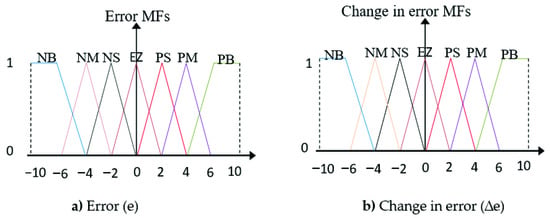
Figure A3.
Membership functions for inputs.

Table A3.
Parameters of the fuzzy logic controller.
Table A3.
Parameters of the fuzzy logic controller.
| Or method | Max |
| And method | Min |
| FIS type | Mamdani |
| Defuzzification | Centroid |
| Implication | Min |
| Aggregation | Max |
The surface, mesh, quiver, and rule of the fuzzy logic controller are illustrated in Figure A4, Figure A5, Figure A6, and Figure A7, respectively.
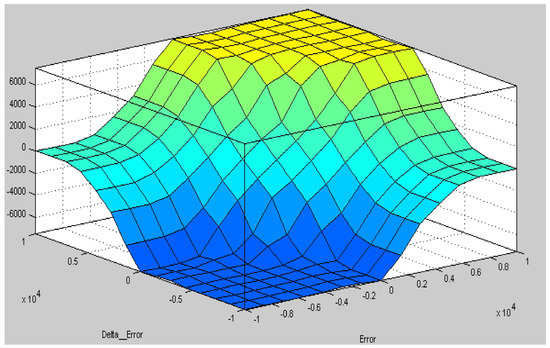
Figure A4.
Surface.
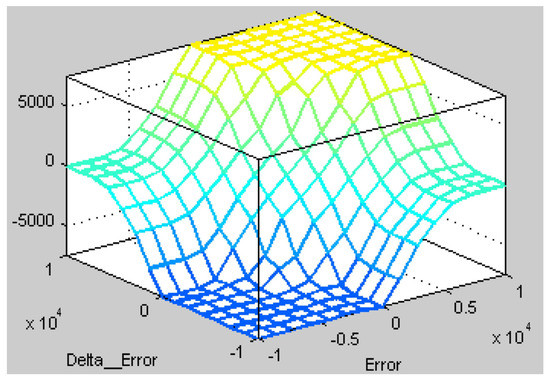
Figure A5.
Mesh. The figure has been changed.
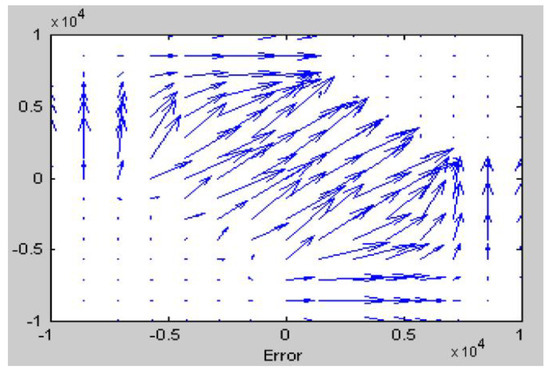
Figure A6.
Quiver.

Figure A7.
Rule.
Appendix C. Design of the Feedforward Neural Network
The design of the feedforward neural networks (FNNs) will be detailed here. This algorithm is similar to the conventional neural network. This algorithm does not need the mathematical model of systems [58]. However, FNNs are also multi-layered networks of neurons (MLN). This type of network is called feedforward because the information only travels forward in the neural network, through the input modes then through the hidden layers (single or many layers), and finally through the output modes. The FNN doesn’t require a prior mathematical model. A learning algorithm is used during the training and learning phase to adjust sequentially by trial and error the synaptic weights of the neurons. In order to train the FNN controllers, we used the Levenberg-Marquardt backpropagation. This method is a simple algorithm. However, the FNN controllers structure consists of 3 layers: output layer, hidden layer, and input layer. An example of the learning process in an FNN applied to the identification of PI controller is shown in Figure A8. In this context, the input vectors are the errors of the active and reactive powers, and the output vectors are the direct and quadrature rotor voltages.

Figure A8.
A learning algorithm in an FNN model.
There is no certain criterion in FNN control for selecting the number of neurons in the hidden layer, but enough neurons are needed to obtain the desired characteristic [59]. Generally, in designing and training the FNN, certain considerations have to be taken to be able to get the best result, i.e., by choosing the number and types of neurons in the hidden layer to find the best solution, avoiding local minima in the error space.
By Equation (A1), the value of the hidden layer can be easily calculated:
where vj represents the jth neuron in the hidden layer, xi represents the ith neuron in the input layer, and the weight between neurons is represented by Wij.
The output layer node value can be computed using Equation (A2).
where m represents the output layer mode.
The error between actual and computed data has been calculated using Equation (A3):
where a represents the propagation form of the actual data for the output and the hidden layers, as expressed in Equations (A4) and (A5), respectively.
The weight adjustment between layers can be carried out using Equations (A6) and (A7):
where α represents the learning rate and, additionally, momentum can be measured as Equations (A8) and (A9), respectively.
where β represents momentum constant and n indicates iterations of error backpropagation.
The training process in the flat region of the error surface avoids variations in the weights and has been accelerated using this momentum technique. Three types of functions can be used in the outer layer and the inner layer. These functions are the tang-sigmoid, linear, and logarithmic sigmoid functions.
The number of neurons in the hidden layer is obtained by trial-and-error exercises to have good results for both the effective power ripples and the THD value of the current.
To obtain an FNN controller, we need to designate several elements that represent one of the conditions for accomplishing this controller and they are explained in detail with the values taken in this work in Table A4.

Table A4.
Parameters of the FNN controller.
Table A4.
Parameters of the FNN controller.
| Parameters | Values |
|---|---|
| Performances | Mean Squared Error (mse) |
| Training | Levenberg-Marquardt algorithm (trainlm) |
| TrainParam.show | 50 |
| TrainParam.Lr | 0.05 |
| Neurons of output layer | 1 |
| TrainParam.goal | 0 |
| TrainParam.mu | 0.8 |
| Neurons of input layer | 1 |
| Coeff. of acceleration of convergence (mc) | 0.9 |
| Derivative | Default (default deriv) |
| Number of hidden layers | 1 |
| Functions of activation | Tensing, Purling, trainlm |
| Number of output layer | 1 |
| TrainParam.eposh | 250 |
| Number of input layer | 1 |
| Neurons of hidden layer | 8 |
In neural networks, output and input layer neurons are selected according to the number of inputs and outputs of the system, respectively. The number of entries is one in the entry layer, so the number of cells is only one. As for the output layer, there is only one output, so there is only one cell.
The neurons of the hidden layer are chosen randomly and there is no rule for choosing them. This is the real problem with neural networks that there is no rule for selecting both the neurons of the hidden layer and even the number of hidden layers.
In this work, we chose only one hidden layer and the neurons were randomly selected, and the choice that we got from it with a lower value for THD was used in this work, that is, we performed a series of experiments before choosing 8 neurons in the hidden layer. The structure diagram of the FNN for this paper is illustrated in Figure A9.
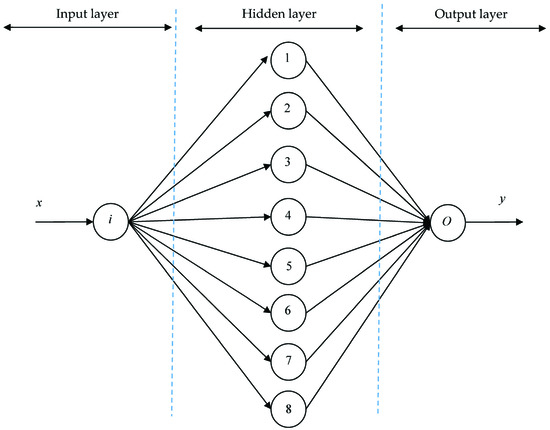
Figure A9.
Structure diagram of the FNN in our designed learning-to-command model.
In an FNN method, the information moves only in the forward direction, from the input layer, through the hidden layers, and then to the output layer. There are no cycles or loops in this network. FNN methods are sometimes ambiguously called multilayer perceptron. This method can be expressed by the following equations:
The activation function is chosen by the designer, but Wi and b are adjusted by some learning rules during the training process of the neural network.
In this work, the weight and bias of the neural network are selected based on the use of a Levenberg-Marquardt algorithm (LMA). This is by using the word trainlm in the Matlab software. However, the LMA technique is a robust algorithm and quick technique compared to other methods. The neural network training is shown in Figure A10. Figure A11 shows the training plot of the FNN controller. From this figure, the best training performance is 8.8189 at epoch 250. The error plot of the FNN algorithm is shown in Figure A12. Through this picture, we find that the targeting field is [−30, 30] and the training value is R = 0.51025, and the output is given by (output = 0.26*Target+8.6). On the other hand, Gradient, Mu, and Validation Checks are shown in Figure A13 and they represent the properties of the FNN algorithm. From this figure, the best Gradient, Mu, and validation checks are 0.021851, 9000, and 0 at epoch 250, respectively.
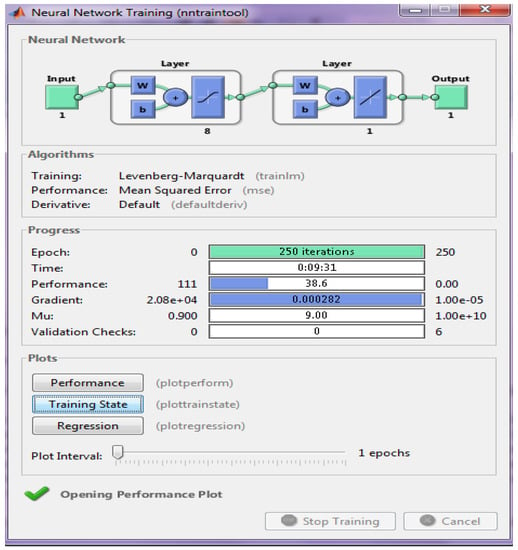
Figure A10.
Neural network training.

Figure A11.
Training plot.
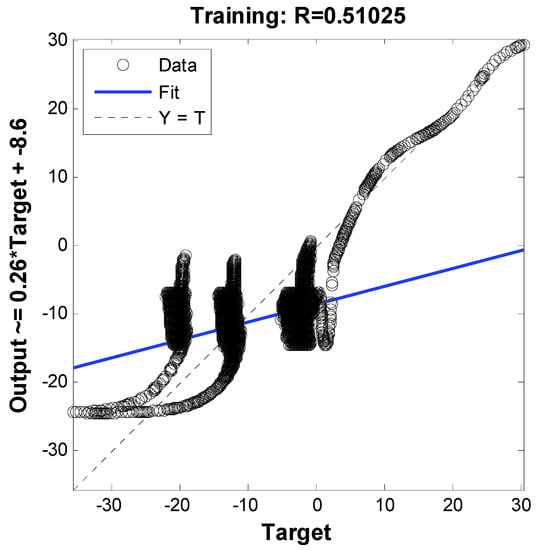
Figure A12.
Error plot.
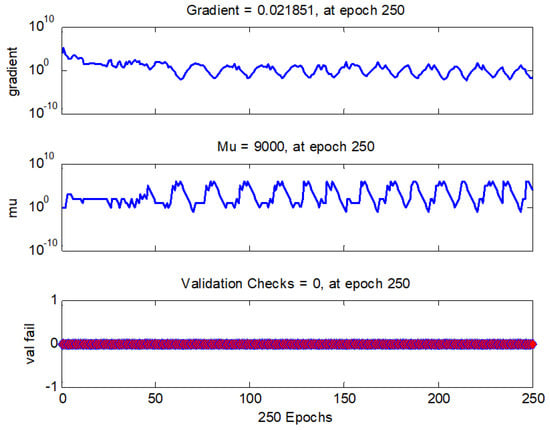
Figure A13.
Characteristics of the FNN controller.
References
- Kumar, P.M.; Sivalingam, K.; Lim, T.-C.; Ramakrishna, S.; Wei, H. Strategies for Enhancing the Low Wind Speed Performance of H-Darrieus Wind Turbine—Part 1. Clean Technol. 2019, 1, 185–204. [Google Scholar] [CrossRef] [Green Version]
- Kumar, P.M.; Sivalingam, K.; Lim, T.-C.; Ramakrishna, S.; Wei, H. Review on the Evolution of Darrieus Vertical Axis Wind Turbine: Large Wind Turbines. Clean Technol. 2019, 1, 205–223. [Google Scholar] [CrossRef] [Green Version]
- Manousakis, N.; Psomopoulos, C.; Ioannidis, G.; Kaminaris, S. A Binary Integer Programming Method for Optimal Wind Turbines Allocation. Clean Technol. 2021, 3, 462–473. [Google Scholar] [CrossRef]
- AlGhamdi, S.; Hamdan, I.; Youssef, M.; Noureldeen, O. Development and Application of Fuzzy Proportional-Integral Control Scheme in Pitch Angle Compensation Loop for Wind Turbines. Machines 2021, 9, 135. [Google Scholar] [CrossRef]
- Abdelrahem, M.; Hackl, C.; Kennel, R. Limited-Position Set Model-Reference Adaptive Observer for Control of DFIGs without Mechanical Sensors. Machines 2020, 8, 72. [Google Scholar] [CrossRef]
- Chen, H.; Xie, W.; Chen, X.; Han, J.; Aït-Ahmed, N.; Zhou, Z.; Tang, T.; Benbouzid, M. Fractional-Order PI Control of DFIG-Based Tidal Stream Turbine. J. Mar. Sci. Eng. 2020, 8, 309. [Google Scholar] [CrossRef]
- Alhato, M.; Ibrahim, M.; Rezk, H.; Bouallègue, S. An Enhanced DC-Link Voltage Response for Wind-Driven Doubly Fed Induction Generator Using Adaptive Fuzzy Extended State Observer and Sliding Mode Control. Mathematics 2021, 9, 963. [Google Scholar] [CrossRef]
- Cortajarena, J.A.; Barambones, O.; Alkorta, P.; Cortajarena, J. Grid Frequency and Amplitude Control Using DFIG Wind Turbines in a Smart Grid. Mathematics 2021, 9, 143. [Google Scholar] [CrossRef]
- Alhato, M.M.; Bouallègue, S.; Rezk, H. Modeling and Performance Improvement of Direct Power Control of Doubly-Fed Induction Generator Based Wind Turbine through Second-Order Sliding Mode Control Approach. Mathematics 2020, 8, 2012. [Google Scholar] [CrossRef]
- Giaourakis, D.G.; Safacas, A.N. Effect of Short-Circuit Faults in the Back-to-Back Power Electronic Converter and Rotor Terminals on the Operational Behavior of the Doubly-Fed Induction Generator Wind Energy Conversion System. Machines 2015, 3, 2–26. [Google Scholar] [CrossRef] [Green Version]
- Benbouhenni, H.; Lemdani, S. Combining synergetic control and super twisting algorithm to reduce the active power undulations of doubly fed induction generator for dual-rotor wind turbine system. Electr. Eng. Electromechanics 2021, 8–17. [Google Scholar] [CrossRef]
- Zahedi, A.H.; Arab, M.G.; Taghipour, B.S. Sliding Mode and Terminal Sliding Mode Control of Cascaded Doubly Fed In-duction Generator. IJEEE 2021, 17, 1955. Available online: http://ijeee.iust.ac.ir/article-1-1955-en.html (accessed on 1 September 2021).
- Hosseinabadi, M.; Rastegar, H. DFIG Based Wind Turbines Behavior Improvement during Wind Variations using Fractional Order Control Systems. IJEEE 2014, 10, 314–323. Available online: http://ijeee.iust.ac.ir/article-1-663-en.html (accessed on 1 September 2021).
- Pour Ebrahim, R.; Tohidi, S.; Younesi, A. Sensorless Model Reference Adaptive Control of DFIG by Using High Frequency Signal Injection and Fuzzy Logic Control. IJEEE 2018, 14, 11–21. [Google Scholar] [CrossRef]
- Heydari, E.; Rafiee, M.; Pichan, M. Fuzzy-Genetic Algorithm-Based Direct Power Control Strategy for DFIG. IJEEE 2018, 14, 353–361. Available online: http://ijeee.iust.ac.ir/article-1-1185-en.html (accessed on 1 September 2021).
- Djeriri, Y. Lyapunov-Based Robust Power Controllers for a Doubly Fed Induction Generator. IJEEE 2020, 16, 551–558. Available online: http://ijeee.iust.ac.ir/article-1-1596-en.html (accessed on 1 September 2021).
- Kaloi, G.S.; Baloch, M.H.; Kumar, M.; Soomro, D.M.; Chauhdary, S.T.; Memon, A.A.; Ishak, D. An LVRT Scheme for Grid Connected DFIG Based WECS Using State Feedback Linearization Control Technique. Electronics 2019, 8, 777. [Google Scholar] [CrossRef] [Green Version]
- Mossa, M.A.; Echeikh, H.; Diab, A.A.Z.; Quynh, N.V. Effective Direct Power Control for a Sensor-Less Doubly Fed Induction Generator with a Losses Minimization Criterion. Electronics 2020, 9, 1269. [Google Scholar] [CrossRef]
- Peng, X.; Chen, R.; Zhou, J.; Qin, S.; Bi, R.; Sun, H. Research on Mechanism and Damping Control Strategy of DFIG-Based Wind Farm Grid-Connected System SSR Based on the Complex Torque Method. Electronics 2021, 10, 1640. [Google Scholar] [CrossRef]
- Cui, H.; Li, X.; Wu, G.; Song, Y.; Liu, X.; Luo, D. MPC Based Coordinated Active and Reactive Power Control Strategy of DFIG Wind Farm with Distributed ESSs. Energies 2021, 14, 3906. [Google Scholar] [CrossRef]
- Han, Y.; Ma, R. Adaptive-Gain Second-Order Sliding Mode Direct Power Control for Wind-Turbine-Driven DFIG under Balanced and Unbalanced Grid Voltage. Energies 2019, 12, 3886. [Google Scholar] [CrossRef] [Green Version]
- Medeiros, A.; Ramos, T.; De Oliveira, J.T.; Júnior, M.F.M. Direct Voltage Control of a Doubly Fed Induction Generator by Means of Optimal Strategy. Energies 2020, 13, 770. [Google Scholar] [CrossRef] [Green Version]
- Sami, I.; Ullah, S.; Ali, Z.; Ullah, N.; Ro, J.-S. A Super Twisting Fractional Order Terminal Sliding Mode Control for DFIG-Based Wind Energy Conversion System. Energies 2020, 13, 2158. [Google Scholar] [CrossRef]
- Han, Y.; Li, S.; Du, C. Adaptive Higher-Order Sliding Mode Control of Series-Compensated DFIG-Based Wind Farm for Sub-Synchronous Control Interaction Mitigation. Energies 2020, 13, 5421. [Google Scholar] [CrossRef]
- Cheng, P.; Wu, C.; Ning, F.; He, J. Voltage Modulated DPC Strategy of DFIG Using Extended Power Theory under Unbalanced Grid Voltage Conditions. Energies 2020, 13, 6077. [Google Scholar] [CrossRef]
- Ma, R.; Han, Y.; Pan, W. Variable-Gain Super-Twisting Sliding Mode Damping Control of Series-Compensated DFIG-Based Wind Power System for SSCI Mitigation. Energies 2021, 14, 382. [Google Scholar] [CrossRef]
- Brando, G.; Dannier, A.; Spina, I. Performance Analysis of a Full Order Sensorless Control Adaptive Observer for Doubly-Fed Induction Generator in Grid Connected Operation. Energies 2021, 14, 1254. [Google Scholar] [CrossRef]
- Kroplewski, P.; Morawiec, M.; Jąderko, A.; Odeh, C. Simulation Studies of Control Systems for Doubly Fed Induction Generator Supplied by the Current Source Converter. Energies 2021, 14, 1511. [Google Scholar] [CrossRef]
- Napole, C.; Barambones, O.; Derbeli, M.; Cortajarena, J.; Calvo, I.; Alkorta, P.; Bustamante, P. Double Fed Induction Generator Control Design Based on a Fuzzy Logic Controller for an Oscillating Water Column System. Energies 2021, 14, 3499. [Google Scholar] [CrossRef]
- Susperregui, A.; Herrero, J.M.; Martinez, M.I.; Tapia-Otaegui, G.; Blasco, X. Multi-Objective Optimisation-Based Tuning of Two Second-Order Sliding-Mode Controller Variants for DFIGs Connected to Non-Ideal Grid Voltage. Energies 2019, 12, 3782. [Google Scholar] [CrossRef] [Green Version]
- Mondal, S.; Kastha, D. Improved Direct Torque and Reactive Power Control of a Matrix-Converter-Fed Grid-Connected Doubly Fed Induction Generator. IEEE Trans. Ind. Electron. 2015, 62, 7590–7598. [Google Scholar] [CrossRef]
- Hu, J.; Nian, H.; Hu, B.; He, Y.; Zhu, Z.Q. Direct Active and Reactive Power Regulation of DFIG Using Sliding-Mode Control Approach. IEEE Trans. Energy Convers. 2010, 25, 1028–1039. [Google Scholar] [CrossRef]
- Martinez, M.I.; Tapia, G.; Susperregui, A.; Camblong, H. Sliding-Mode Control for DFIG Rotor- and Grid-Side Converters Under Unbalanced and Harmonically Distorted Grid Voltage. IEEE Trans. Energy Convers. 2012, 27, 328–339. [Google Scholar] [CrossRef]
- Ullah, N.; Sami, I.; Chowdhury, S.; Techato, K.; Alkhammash, H.I. Artificial Intelligence Integrated Fractional Order Control of Doubly Fed Induction Generator-Based Wind Energy System. IEEE Access 2020, 9, 5734–5748. [Google Scholar] [CrossRef]
- De Marchi, R.A.; Dainez, P.S.; Von Zuben, F.J.; Bim, E. A Multilayer Perceptron Controller Applied to the Direct Power Control of a Doubly Fed Induction Generator. IEEE Trans. Sustain. Energy 2014, 5, 498–506. [Google Scholar] [CrossRef]
- Erazo-Damian, I.; Apsley, J.M.; Perini, R.; Iacchetti, M.F.; Marques, G.D. Stand-Alone DFIG FOC Sensitivity and Stability Under Mismatched Inductances. IEEE Trans. Energy Convers. 2018, 34, 860–869. [Google Scholar] [CrossRef]
- Iacchetti, M.F.; Marques, G.; Perini, R. Torque Ripple Reduction in a DFIG-DC System by Resonant Current Controllers. IEEE Trans. Power Electron. 2014, 30, 4244–4254. [Google Scholar] [CrossRef] [Green Version]
- Marques, G.D.; Iacchetti, M.F. DFIG Topologies for DC Networks: A Review on Control and Design Features. IEEE Trans. Power Electron. 2018, 34, 1299–1316. [Google Scholar] [CrossRef]
- Prasad, R.M.; Mulla, M.A. A Novel Position-Sensorless Algorithm for Field-Oriented Control of DFIG With Reduced Current Sensors. IEEE Trans. Sustain. Energy 2018, 10, 1098–1108. [Google Scholar] [CrossRef]
- Prasad, R.M.; Mulla, M.A. Mathematical Modeling and Position-Sensorless Algorithm for Stator-Side Field-Oriented Control of Rotor-Tied DFIG in Rotor Flux Reference Frame. IEEE Trans. Energy Convers. 2019, 35, 631–639. [Google Scholar] [CrossRef]
- Benbouhenni, H. Comparative Study between direct vector control and fuzzy sliding mode controller in three-level space vector modulation inverter of reactive and active power command of DFIG-based wind turbine systems. Int. J. Smart Grid 2018, 2, 188–196. [Google Scholar]
- Benbouhenni, H. Neuro-second order sliding mode field oriented control for DFIG based wind turbine. Int. J. Smart Grid 2018, 2, 209–217. [Google Scholar]
- Habib, B.; Boudjema, Z.; Belaidi, A. Direct vector control of a DFIG supplied by an intelligent SVM inverter for wind turbine system. Iran. J. Electr. Electron. Eng. 2019, 15, 45–55. [Google Scholar]
- Habib, B.; Boudjema, Z.; Belaidi, A. Indirect vector control of a DFIG supplied by a two-level FSVM inverter for wind turbine system. Majlesi J. Electron. Eng. 2019, 13, 45–54. [Google Scholar]
- Amrane, F.; Chaiba, A. A novel direct power control for grid-connected doubly fed induction generator based on hybrid arti-ficial intelligent control with space vector modulation. Rev. Sci. Tech. Electrotechnol. Energy 2016, 61, 263–268. [Google Scholar]
- Amrane, F.; Chaiba, A.; Babas, B.E.; Mekhilef, S. Design and implementation of high performance field oriented control for grid-connected doubly fed induction generator via hysteresis rotor current controller. Rev. Sci. Tech. Electrotechn. Energy 2016, 61, 319–324. [Google Scholar]
- Boulaam, K.; Mekhilef, A. Output power control of a variable wind energy conversion system. Rev. Sci. Tech. Electrotechnol. Energy 2017, 62, 197–202. [Google Scholar]
- Kazmierkowski, M.P.; Malesani, L. Current control techniques for three-phase voltage-source PWM converters: A survey. IEEE Trans. Ind. Electron. 1998, 45, 691–703. [Google Scholar] [CrossRef]
- Nnem, N.L.; Lonla, M.B.; Sonfack, G.B.; Mbih, J. Review of a Multipurpose Duty-Cycle Modulation Technology in Electrical and Electronics Engineering. J. Electr. Eng. Electron. Control Comput. Sci. 2021, 4, 9–18. Available online: https://jeeeccs.net/index.php/journal/article/view/101 (accessed on 1 September 2021).
- El-Masry, E.I.; Yang, H.K.; Yakout, M.A. Implementations of artificial neural networks using current-mode pulse width modulation technique. IEEE Trans. Neural Netw. 1997, 8, 532–548. [Google Scholar] [CrossRef]
- Tzou, Y.-Y.; Lin, S.-Y. Fuzzy-tuning current-vector control of a three-phase PWM inverter for high-performance AC drives. IEEE Trans. Ind. Electron. 1998, 45, 782–791. [Google Scholar] [CrossRef]
- Zadeh, L. Fuzzy sets. Inf. Control. 1965, 8, 338–353. [Google Scholar] [CrossRef] [Green Version]
- Tan, K.-H. Squirrel Cage Induction Generator System Using Wavelet Petri Fuzzy Neural Network Control for Wind Power Applications. IEEE Trans. Power Electron. 2015, 31, 1. [Google Scholar] [CrossRef]
- Mas’Ud, A.A.; Ardila-Rey, J.A.; Albarracín, R.; Muhammad-Sukki, F.; Bani, N.A. Comparison of the Performance of Artificial Neural Networks and Fuzzy Logic for Recognizing Different Partial Discharge Sources. Energies 2017, 10, 1060. [Google Scholar] [CrossRef] [Green Version]
- Ayrir, W.; Ourahou, M.; El Hassouni, B.; Haddi, A. Direct torque control improvement of a variable speed DFIG based on a fuzzy inference system. Math. Comput. Simul. 2018, 167, 308–324. [Google Scholar] [CrossRef]
- Yahdou, A.; Hemici, B.; Boudjema, Z. Sliding mode control of dual rotor wind turbine system. Mediterr. J. Meas. Control 2015, 11, 412–419. [Google Scholar]
- Yahdou, A.; Djilali, A.B.; Boudjema, Z.; Mehedi, F. Improved Vector Control of a Counter-Rotating Wind Turbine System Using Adaptive Backstepping Sliding Mode. J. Eur. Syst. Autom. 2020, 53, 645–651. [Google Scholar] [CrossRef]
- Nag, S.; Lee, K. Neural Network-Based Control for Hybrid PV and Ternary Pumped-Storage Hydro Plants. Energies 2021, 14, 4397. [Google Scholar] [CrossRef]
- Fayaz, M.; Ullah, I.; Kim, D. An Optimized Fuzzy Logic Control Model Based on a Strategy for the Learning of Membership Functions in an Indoor Environment. Electronics 2019, 8, 132. [Google Scholar] [CrossRef] [Green Version]
- Ibrahim, Y.; Semmah, A.; Patrice, W. Neuro-Second Order Sliding Mode Control of a DFIG based Wind Turbine System. J. Electr. Electron. Eng. 2020, 13, 63–68. [Google Scholar]
- Boudjema, Z.; Taleb, R.; Djeriri, Y.; Yahdou, A. A novel direct torque control using second order continuous sliding mode of a doubly fed induction generator for a wind energy conversion system. Turk. J. Electr. Eng. Comput. Sci. 2017, 25, 965–975. [Google Scholar] [CrossRef] [Green Version]
- Amrane, F.; Francois, B.; Chaiba, A. Experimental investigation of efficient and simple wind-turbine based on DFIG-direct power control using LCL-filter for stand-alone mode. ISA Trans. 2021. [Google Scholar] [CrossRef]
- Yusoff, N.A.M.; Razali, A.M.; Karim, K.A.; Sutikno, T.; Jidin, A. A Concept of Virtual-Flux Direct Power Control of Three-Phase AC-DC Converter. Int. J. Power Electron. Drive Syst. (IJPEDS) 2017, 8, 1776–1784. [Google Scholar] [CrossRef] [Green Version]
- Boudjema, Z.; Meroufel, A.; Djerriri, Y.; Bounadja, E. Fuzzy sliding mode control of a doubly fed induction generator for energy conversion. Carpathian J. Electron. Comput. Eng. 2013, 6, 7–14. [Google Scholar]
- Yahdou, A.; Hemici, B.; Boudjema, Z. Second order sliding mode control of a dual-rotor wind turbine system by employing a matrix converter. J. Electr. Eng. 2016, 16, 1–11. [Google Scholar]
- Yaichi, I.; Semmah, A.; Wira, P.; Djeriri, Y. Super-twisting Sliding Mode Control of a Doubly-fed Induction Generator Based on the SVM Strategy. Period. Polytech. Electr. Eng. Comput. Sci. 2019, 63, 178–190. [Google Scholar] [CrossRef]
- Benbouhenni, H.; Bizon, N. A Synergetic Sliding Mode Controller Applied to Direct Field-Oriented Control of Induction Generator-Based Variable Speed Dual-Rotor Wind Turbines. Energies 2021, 14, 4437. [Google Scholar] [CrossRef]
- Quan, Y.; Hang, L.; He, Y.; Zhang, Y. Multi-Resonant-Based Sliding Mode Control of DFIG-Based Wind System under Unbalanced and Harmonic Network Conditions. Appl. Sci. 2019, 9, 1124. [Google Scholar] [CrossRef] [Green Version]
- Benbouhenni, H.; Bizon, N. Terminal Synergetic Control for Direct Active and Reactive Powers in Asynchronous Generator-Based Dual-Rotor Wind Power Systems. Electronics 2021, 10, 1880. [Google Scholar] [CrossRef]
- El Ouanjli, N.; Derouich, A.; El Ghzizal, A.; Taoussi, M.; EL Mourabit, Y.; Mezioui, K.; Bossoufi, B. Direct torque control of doubly fed induction motor using three-level NPC inverter. Prot. Control Mod. Power Syst. 2019, 4, 1–9. [Google Scholar] [CrossRef] [Green Version]
- Benbouhenni, H. Intelligent super twisting high order sliding mode controller of dual-rotor wind power systems with direct attack based on doubly-fed induction generators. J. Electr. Eng. Electron. Control Comput. Sci. 2021, 7, 1–8. Available online: https://jeeeccs.net/index.php/journal/article/view/219 (accessed on 1 September 2021).
- Benbouhenni, H. Synergetic control theory scheme for asynchronous generator based dual-rotor wind power. J. Electr. Eng. Electron. Control Comput. Sci. 2021, 7, 19–28. Available online: https://jeeeccs.net/index.php/journal/article/view/215 (accessed on 1 September 2021).
Publisher’s Note: MDPI stays neutral with regard to jurisdictional claims in published maps and institutional affiliations. |
© 2021 by the authors. Licensee MDPI, Basel, Switzerland. This article is an open access article distributed under the terms and conditions of the Creative Commons Attribution (CC BY) license (https://creativecommons.org/licenses/by/4.0/).